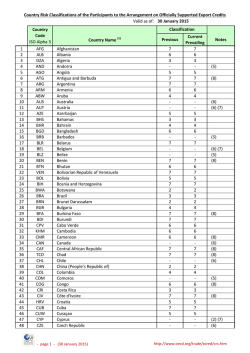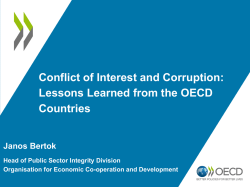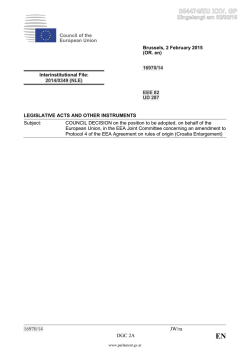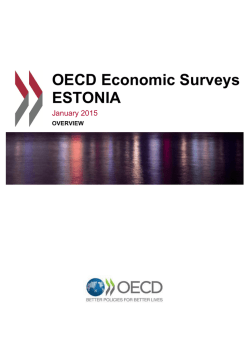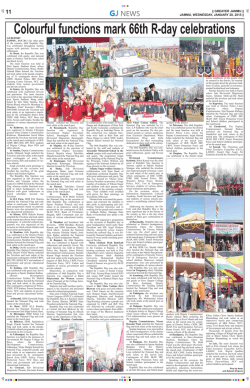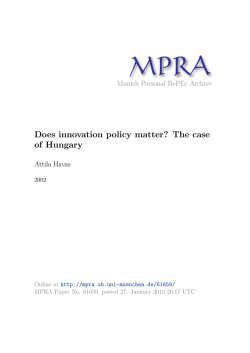
Presentación Education at a Glance Interim Report 2015
Education at a Glance Interim Report: Update of Employment and Educational Attainment Indicators January 2015 1 The social consequences of the crisis are still deepening in 2013, especially among the most vulnerable groups such as loweducated young adults Chapter 1 TO WHAT LEVEL HAVE ADULTS STUDIED? 4 Less than 1/5 of younger adults have not reached upper secondary In most OECD countries more than four out of five younger adults have attained at least an upper secondary education, implying that less than 20% of them have qualifications below upper secondary education. Less than 1/5 of younger adults have not reached upper secondary education Educational attainment among younger (25-34 year-olds) adults (2013) Tertiary Upper secondary or post-secondary non-tertiary Below upper secondary 100% 90% 39 39 80% 70% 35 34 27 27 9 9 40 31 39 41 39 33 24 6 6 6 6 2 37 36 43 47 40 38 38 42 41 46 36 47 45 47 46 51 44 60 56 52 64 57 65 64 54 50 45 25 23 67 30% 41 20% 22 25 6 35 50% 10% 7 31 52 52 60% 40% 11 11 10 9 14 14 14 13 13 13 13 12 15 15 16 17 18 18 18 23 21 29 41 43 41 40 26 15 23 47 40 37 58 51 48 48 43 44 46 41 27 22 45 45 43 45 40 44 31 57 42 30 25 37 29 Korea Slovenia Russian Federation Czech Republic Poland Slovak Republic Canada Sweden Finland Israel Switzerland United States Austria Estonia Hungary Germany Ireland Latvia United Kingdom Luxembourg Australia France Netherlands Greece OECD average Norway Denmark Belgium New Zealand Chile Iceland Italy Colombia Spain Brazil Portugal Mexico Turkey 0% 6 Lower proportion of older adults have tertiary credentials In 2013, on average across OECD countries, 34% of older adults (55-64 year-olds) have not attained upper secondary level. Brazil, Colombia, Italy, Mexico, Portugal, Spain and Turkey have the highest proportion of older adults with low qualifications as well as the highest share of younger adults with low qualifications. Lower proportion of older adults have tertiary credentials Chart 1.1 Educational attainment among older (55-64 year-olds) adults (2013) Below upper secondary Upper secondary or post-secondary non-tertiary Tertiary 100% 10 90% 13 12 11 11 12 80% 10 20 15 12 13 26 30 26 29 31 25 21 27 20 16 30 27 18 16 70% 25 26 25 34 42 18 45 47 49 36 30 60% 32 39 50% 43 33 31 38 41 46 37 51 74 79 72 62 30% 60 63 31 55 69 20% 42 39 35 40 48 62 56 44 51 53 56 71 70 73 49 49 42 30 10% 35 34 41 38 39 27 30 18 24 15 12 26 26 22 24 19 17 15 15 17 13 10 8 United States 79 57 60 Austria 40% 41 32 15 32 29 30 35 25 32 17 14 13 14 16 10 Korea Slovenia Russian Federation Czech Republic Poland Slovak Republic Canada Sweden Finland Israel Switzerland Estonia Hungary Germany Ireland Latvia United Kingdom Luxembourg Australia France Netherlands Greece OECD average Norway Denmark Belgium New Zealand Chile Iceland Italy Colombia Spain Brazil Portugal Mexico Turkey 0% 8 There is a larger proportion of young men with low qualifications compared to young women On average across OECD countries, 18% of younger men (25-34 year-olds) have not attained an upper secondary education while the percentage among younger women is 15%. In Australia, Brazil, Colombia, Denmark, Estonia, Greece, Iceland, Italy, Latvia and Norway the gender difference across younger adults is wider than 5 percentage points, and in Portugal and Spain it is larger than 10 percentage points. Turkey Austria Switzerland Mexico Slovak Republic Korea Czech Republic Germany Hungary United Kingdom Chile New Zealand Sweden Russian Federation Poland Slovenia France United States Men Canada OECD average Finland Ireland Belgium % Netherlands Israel Luxembourg Norway Australia Colombia Greece Iceland Italy Estonia Latvia Denmark Brazil Spain Portugal There is a larger proportion of young men with low qualifications compared to young women Chart 1.2 Percentage of younger adults (25-34 year-olds) with attainment below upper secondary education, by gender (2013) Women 60 55 50 45 40 35 30 25 20 15 10 5 0 10 The proportion of younger adults with tertiary education increased in all countries between 2000 and 2013 On average across OECD countries, the percentage of younger adults (25-34 year-olds) with tertiary education increased by 14 percentage points between 2000 and 2013. The increase was lowest in Finland (1 percentage point) and highest in Korea, Luxembourg and Poland (25 percentage points or more). Finland Germany Belgium United States Spain Mexico Canada Iceland Japan Austria Sweden New Zealand Norway Denmark Estonia 2000 Italy France Greece Turkey % OECD average Australia Netherlands Hungary Portugal Switzerland Czech Republic Slovenia Slovak Republic United Kingdom Ireland Latvia Luxembourg Poland Korea The proportion of younger adults with tertiary education increased in all countries between 2000 and 2013 Chart 1.4 Percentage of younger adults (25-34 year-olds) with tertiary education (2000 and 2013) 70 2013 60 50 40 30 20 10 0 Chapter 2 HOW DOES EDUCATIONAL ATTAINMENT AFFECT PARTICIPATION IN THE LABOUR MARKET? 13 Employment rates increase with education in all countries On average across OECD countries the employment rate of 25-64 year-olds without an upper secondary qualification was as low as 55%, and 83% for those with a tertiary education. For adults without an upper secondary qualification the employment rate was lower than 40% in the Slovak Republic, Hungary and Poland. For adults with a tertiary qualification the employment rate was about 90% in Austria, Denmark, Germany, Iceland, the Netherlands, Norway, Sweden and Switzerland. Iceland Norway Sweden Switzerland Netherlands Germany Austria Denmark New Zealand Latvia Israel Upper secondary or post-secondary non-tertiary Brazil Czech Republic Luxembourg Poland United Kingdom France Chile Belgium Finland Slovenia Colombia Australia Estonia OECD average Russian Federation Tertiary education Canada Japan United States Portugal Hungary Ireland Mexico % Slovak Republic Italy Korea Turkey Spain Greece Employment rates increase with education in all countries Chart 2.1 Employment rates among adults (25-64 year-olds) by educational attainment (2013) 100 Below upper secondary 90 80 70 60 50 40 30 20 10 0 15 More tertiary educated young men are employed but… more women have tertiary credentials On average across OECD countries there is a gender gap in employment even for tertiary educated young adults: 87% of tertiary-educated men are employed versus 78% of tertiary educated women. Even if employment is higher among tertiary educated men, data show that 25-34 year-old women have consistently higher attainment rates at the tertiary level compared with men of the same age. Across OECD countries, 46% of young women have reached tertiary education while it is the case for 35% of young men. More tertiary educated young men are employed but more women have tertiary credentials Chart 2.2 Employment rates among young adults (25-34 year-olds) with tertiary education, by gender (2013) Employment Women Tertiary education attainment Men Russian Federation Netherlands Norway Brazil Belgium Switzerland Sweden Germany France Austria Denmark Luxembourg Israel Latvia United Kingdom Canada Iceland Chile Ireland Slovenia Poland Colombia New Zealand United States Australia OECD average Finland Portugal Japan Mexico Hungary Estonia Spain Slovak Republic Czech Republic Turkey Korea Italy Greece 100 Russian Federation Netherlands Norway Brazil Belgium Switzerland Sweden Germany France Austria Denmark Luxembourg Israel Latvia United Kingdom Canada Iceland Chile Ireland Slovenia Poland Colombia New Zealand United States Australia OECD average Finland Portugal Japan Mexico Hungary Estonia Spain Slovak Republic Czech Republic Turkey Korea Italy Greece 90 80 70 60 50 40 30 20 10 0 0 10 20 30 40 50 60 70 80 90 100 17 Small gap in unemployment among tertiary educated men and women On average across OECD countries the gender gap in unemployment for tertiary educated young adults is very small: 7% of tertiary-educated men are unemployed versus 8% of tertiary educated women. In 7 countries tertiary-educated women have lower unemployment rates than men, with a difference of over 2 percentage points: Colombia, Greece, Poland, Portugal, the Slovak Republic, Slovenia and Turkey. Luxembourg Korea Netherlands Ireland France Canada Estonia United States United Kingdom Japan Mexico Switzerland Sweden Finland Denmark Women Germany Russian Federation Australia Latvia Belgium Data for Greece: Women= 36%; Men= 30% Chile Israel OECD average Hungary Czech Republic New Zealand Spain Italy Austria Brazil Poland Slovak Republic Colombia % 22 Slovenia Greece Portugal Turkey Small gap in unemployment among tertiary educated men and women Chart 2.5 Unemployment rates among young adults (25-34 year-olds) with tertiary education, by gender (2013) Men 20 18 16 14 12 10 8 6 4 2 0 19 The gender gap widens among young adults with low qualification Across OECD countries, the gender gap is larger for young adults without an upper secondary education compared with young adults with a tertiary qualification: 67% of young men and 42% of young women without upper secondary education are employed. The gender gap is over 40 percentage points in Colombia, Mexico and Turkey. Portugal Spain Norway Switzerland Slovak Republic Ireland Korea Russian Federation Netherlands Austria Iceland Belgium Denmark Germany Latvia Greece Finland Women OECD average Hungary Czech Republic Canada Luxembourg % 100 France Estonia Australia United Kingdom Poland Sweden Italy United States New Zealand Brazil Slovenia Chile Israel Colombia Mexico Turkey The gender gap widens among young adults with low qualifications Chart 2.3 Employment rates among young adults (25-34 year-olds) with attainment below upper secondary education, by gender (2013) Men 90 80 70 60 50 40 30 20 10 0 21 Higher employment rates for vocational qualifications among upper secondary education Across OECD countries, among 25-64 year-olds with upper secondary education as highest level of education the employment rate of adults with vocational qualifications was 75% on average, while it was 69% on average for those with general qualifications. In Denmark and Germany employment rate for adults with a vocational upper secondary education is 15 percentage points or more above the employment rate for adults with a general upper secondary education. Higher employment rates for vocational qualifications among upper secondary education Chart 2.4 Employment rates among adults (25-64 year-olds) with upper secondary education as highest level of education attained, by type of programme (2013) Vocational % 100 General 90 80 70 60 50 40 30 20 10 Iceland Sweden New Zealand Switzerland Australia Germany Denmark Canada Israel Netherlands Austria Russian Federation Czech Republic Belgium OECD average Estonia Chile Finland France Italy Latvia Luxembourg Slovak Republic Slovenia Hungary Ireland Turkey Spain Greece 0 Chapter 3 TRANSITION FROM SCHOOL TO WORK: WHERE ARE THE 15-29 YEAR-OLDS? 24 Almost one in five 20-24 year-olds is NEET Among the 20-24 year-olds, 55% were not in education of which 26% were employed, 10% unemployed and 9% not looking for a job. So, about 19% can be seen as NEET (people neither employed nor in education or training). The NEET population is over 25% in 7 countries: Colombia, Greece, Hungary, Italy, Mexico, Spain and Turkey. Almost one in five 20-24 year-olds is NEET Chart 3.1 Distribution of 20-24 year-olds not in education, by work status (2013) % Employed 80 70 15 9 7 11 50 Inactive 12 20 60 Unemployed 27 6 5 12 10 10 5 7 6 7 4 17 9 5 7 6 5 19 13 5 8 40 4 17 5 5 6 9 7 11 9 8 16 13 10 14 13 7 49 47 46 20 8 11 7 8 25 30 54 8 6 16 6 8 8 8 6 4 8 6 4 12 26 0 5 8 5 52 43 45 49 35 33 26 10 10 46 45 44 4 37 30 42 33 36 34 33 35 33 21 29 36 34 37 36 28 32 26 19 19 2 6 22 Luxembourg Slovenia Denmark Iceland Netherlands Germany Poland Finland Czech Republic Portugal Greece Estonia Spain Latvia OECD average France Slovak Republic Sweden Ireland Belgium Switzerland Hungary Korea Canada Australia Italy Norway New Zealand United States Austria United Kingdom Turkey Israel Mexico Colombia 0 26 Employed 15-29 year-olds not in education are mostly working full time Among the 15-29 year-olds who are not in education and are working, 68% were working 35 hours or more per week. In Denmark, Finland, Ireland, the Netherlands and Sweden 60% or less young adults not studying but working are working 35 hours or more per week. Employed 15-29 year-olds not in education are mostly working full time Chart 3.4 Employed (%) Number of hours worked in a week, by 15-29 year-olds not in education (2013) Turkey Latvia Poland Slovak Republic Hungary Australia Mexico Estonia Colombia United States Czech Republic Slovenia Israel Greece Germany Luxembourg Portugal Belgium OECD average France Italy Austria Switzerland Spain Canada United Kingdom Iceland Denmark Finland Ireland Sweden Netherlands 32 39 34 37 34 42 42 37 42 39 40 30 43 24 37 36 31 38 37 36 28 45 44 27 43 43 34 29 32 34 38 37 Distribution of working hours among 15-29 year-olds not in education and employed 0 10 20 30 40 50 60 70 80 90 100 Number of hours worked in a week: 35+ 10-34 1-9 0 Unknown Thank you Find out more about our work at: www.oecd.org/edu/eag.htm www.oecd.org/edu/eag-interim-report.htm - The publication - The methodologies - The complete database Email: [email protected] Twitter: SchleicherEDU and remember: Without data, you are just another person with an opinion
© Copyright 2025
